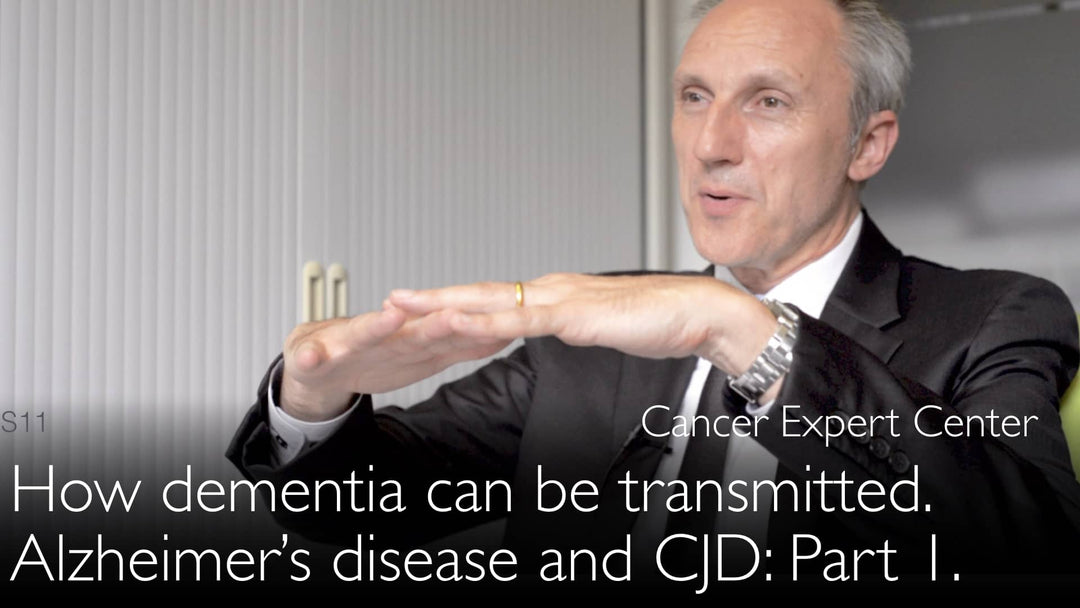Leading expert in neurodegenerative diseases, Dr. Sebastian Brandner, MD, explains how certain dementia-causing proteins can be transmitted through medical procedures. While Alzheimer's disease itself isn't contagious, its amyloid beta proteins can spread via contaminated growth hormone treatments or surgical grafts, potentially causing cerebral amyloid angiopathy decades later. The interview reveals striking parallels between prion diseases like Creutzfeldt-Jakob and Alzheimer's-related protein transmission mechanisms.
Medical Transmission of Dementia Proteins: Risks of Amyloid Beta and Prion Contamination
Jump To Section
- Prion Transmission Through Medical Procedures
- Growth Hormone Contamination Risks
- Dura Mater Grafts and CJD Outbreaks
- From BSE to Variant CJD in Humans
- Alzheimer's Protein Transmission Mechanism
- Cerebral Amyloid Angiopathy Development
- Spontaneous vs. Transmitted Neurodegeneration
- Full Transcript
Prion Transmission Through Medical Procedures
Dr. Sebastian Brandner, MD, details how Creutzfeldt-Jakob disease (CJD) transmission occurred through contaminated medical treatments. The neuropathologist explains that pooled growth hormone extracts from cadavers' pituitary glands caused iatrogenic CJD cases, with over 400,000 glands collected in the UK alone between 1958-1985. This historical medical practice demonstrates how prion proteins can survive standard disinfection methods.
Growth Hormone Contamination Risks
The interview reveals how growth hormone preparation methods varied internationally, with some countries continuing risky practices after 1985. Dr. Sebastian Brandner, MD, notes that while synthetic growth hormone replaced cadaver-derived products, the delay in this transition allowed continued prion transmission. This medical history lesson underscores the importance of rigorous biological product safety standards.
Dura Mater Grafts and CJD Outbreaks
Neurosurgical procedures using cadaver-derived dura mater caused significant iatrogenic CJD clusters, particularly in Japan. Dr. Sebastian Brandner, MD, reports that over 200 patients developed CJD from contaminated grafts, despite disinfection attempts. These cases prove that brain membrane transplants can transmit prion diseases decades after the initial exposure.
From BSE to Variant CJD in Humans
The UK's bovine spongiform encephalopathy (BSE) epidemic infected over 170,000 cattle, entering the human food chain and causing variant CJD. Dr. Sebastian Brandner, MD, explains this zoonotic transmission created a distinct prion disease pathology different from classical CJD. The outbreak highlights how animal prion diseases can jump species barriers with devastating consequences.
Alzheimer's Protein Transmission Mechanism
Groundbreaking research reveals amyloid beta proteins - associated with Alzheimer's disease - can transmit alongside prions. Dr. Sebastian Brandner, MD, describes how contaminated growth hormone preparations contained both prion and amyloid beta proteins. This co-transmission occurs through the same iatrogenic routes as CJD, though with different clinical manifestations.
Cerebral Amyloid Angiopathy Development
Unlike full Alzheimer's disease transmission, amyloid beta proteins cause cerebral amyloid angiopathy - a vascular disorder making brain blood vessels brittle. Dr. Sebastian Brandner, MD, notes this condition emerges 20-30 years post-exposure, featuring Alzheimer's-type plaques but primarily affecting blood vessels rather than brain tissue directly.
Spontaneous vs. Transmitted Neurodegeneration
Dr. Sebastian Brandner, MD, clarifies that 95% of both Alzheimer's and CJD cases occur spontaneously. However, once pathogenic proteins exist, they can transmit through medical procedures involving brain tissue. Dr. Sebastian Brandner, MD, emphasizes this doesn't mean Alzheimer's disease is contagious, but rather its component proteins can seed pathology in recipients under specific circumstances.
Full Transcript
Dr. Anton Titov, MD: Creutzfeldt-Jakob disease can also be transmitted via medical procedures, such as the injection of growth hormone extracts. These extracts were pooled during preparation from tens of thousands of pituitary glands from human cadavers. The growth hormone was administered to patients who had growth problems in their teens, and some of them developed Creutzfeldt-Jakob disease.
Dr. Sebastian Brandner, MD: It was discovered that this was a problem in 1985, after which genetically engineered growth hormone was used instead. However, risks of Creutzfeldt-Jakob disease remained because growth hormone preparation practices varied between countries. In the UK, over 400,000 pituitary glands were collected between 1958 and 1985 for growth hormone preparation, explaining the human iatrogenic transmission of CJD. "Iatrogenic" means the disease was transmitted through medical procedures.
Another common transmission method for Creutzfeldt-Jakob disease was via "dura mater," a covering of the brain often used in neurosurgery for wound repair. Small patches of dura mater derived from cadavers were placed after brain trauma or tumor surgery. Despite disinfection, many patients developed iatrogenic CJD, particularly in Japan, where over 200 infected grafts led to cases of the disease.
Creutzfeldt-Jakob disease is also transmissible through Bovine Spongiform Encephalopathy (BSE), which affected cattle in the UK. More than 170,000 cattle had BSE, and prions entered the human food chain, causing over 200 cases of "variant CJD." This variant resembles cattle BSE pathology rather than typical human CJD.
Dr. Sebastian Brandner, MD: The transmissibility of protein diseases like CJD is not limited to prions. Last year, we described in a clinical trial that the protein involved in Alzheimer's disease can also be transmitted similarly. Amyloid beta, an Alzheimer-type protein, was co-transmitted with CJD prions in growth hormone extracts. This led to neurodegeneration after 20–30 years, causing cerebral amyloid angiopathy—a condition where proteins deposit in blood vessel walls, making them brittle and prone to bleeding.
Dr. Anton Titov, MD: Let’s return to the concept of CJD and also discuss Alzheimer's disease. While both have genetic influences, the vast majority of cases (95%) arise spontaneously. However, once the disease occurs, it can be transmitted via biological material.
Dr. Sebastian Brandner, MD: Yes, that's correct. Alzheimer’s disease and CJD can be transmitted through medical procedures involving brain tissue. We don’t yet know how risky or common this is, but we can transmit the protein that deposits and amplifies in the recipient brain. This doesn’t mean we transmit Alzheimer's disease itself, but the protein can cause vascular problems like cerebral amyloid angiopathy.
Dr. Anton Titov, MD: This introduces a whole new concept of disease transmission.
Dr. Sebastian Brandner, MD: Yes, it’s remarkable. These diseases aren’t bacterial or viral—they’re caused by proteins that trigger degenerative changes in the brain.







